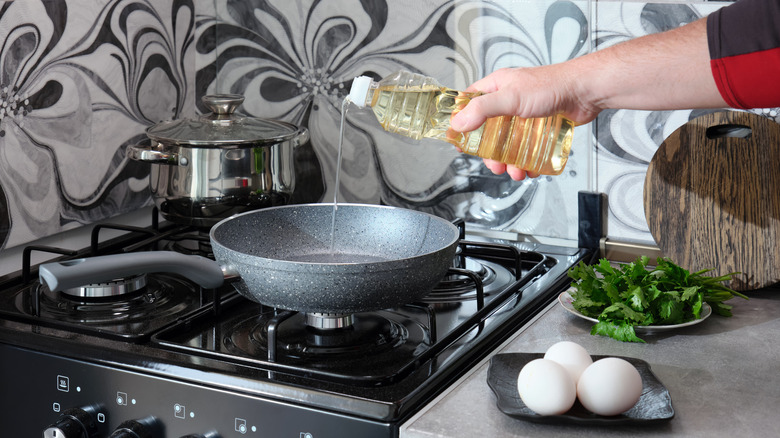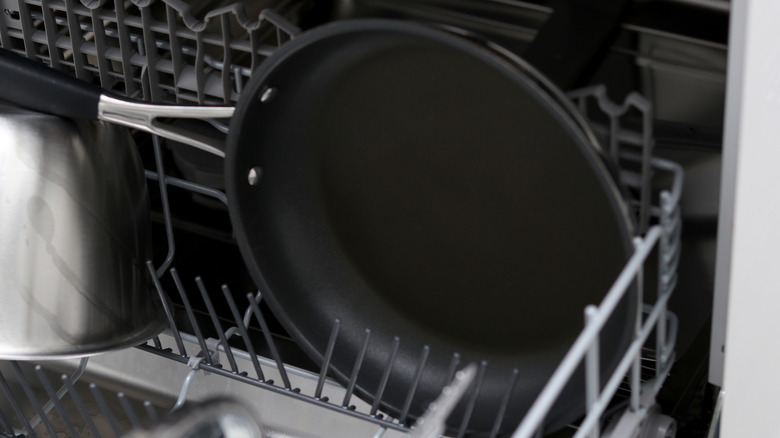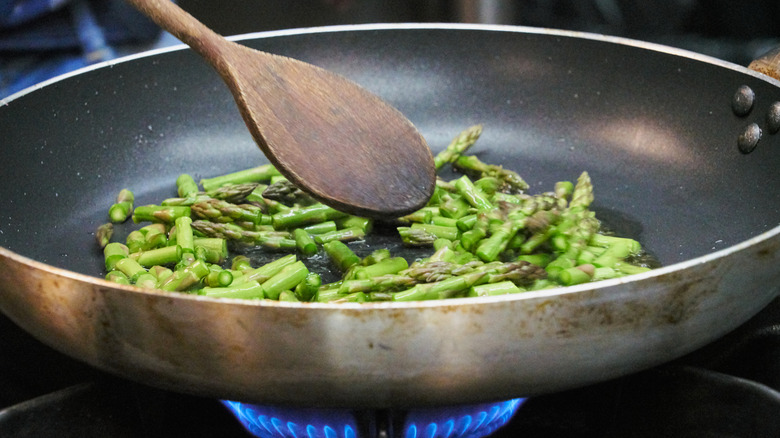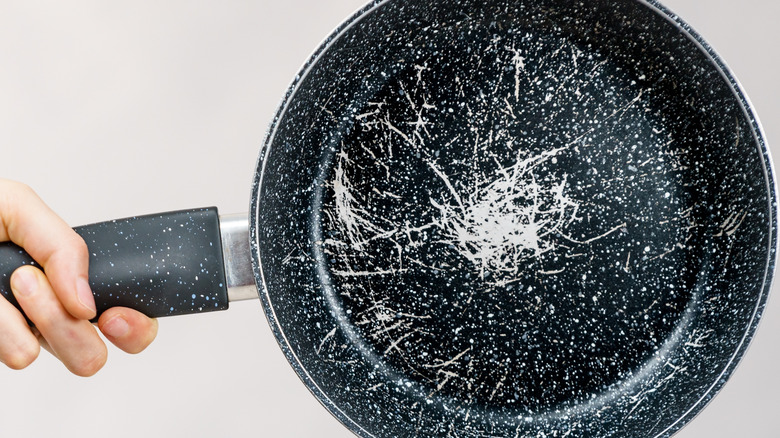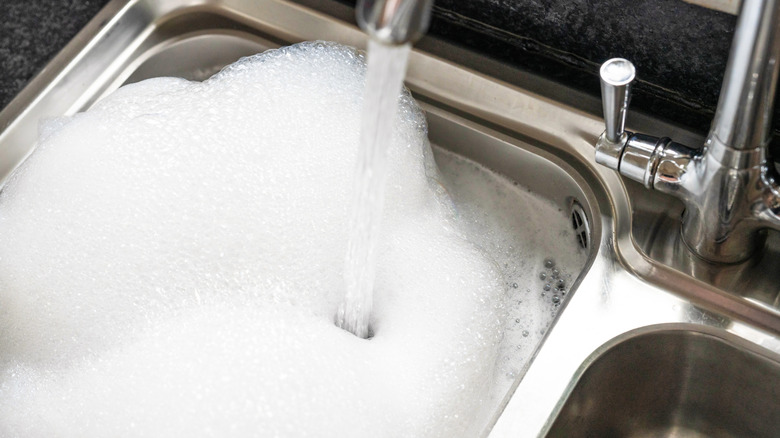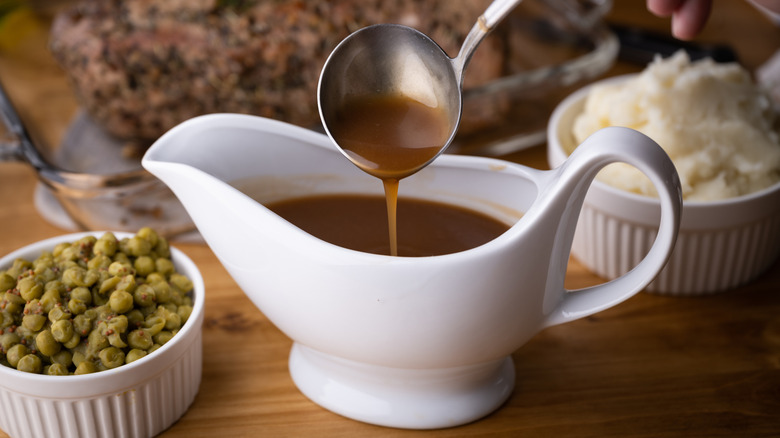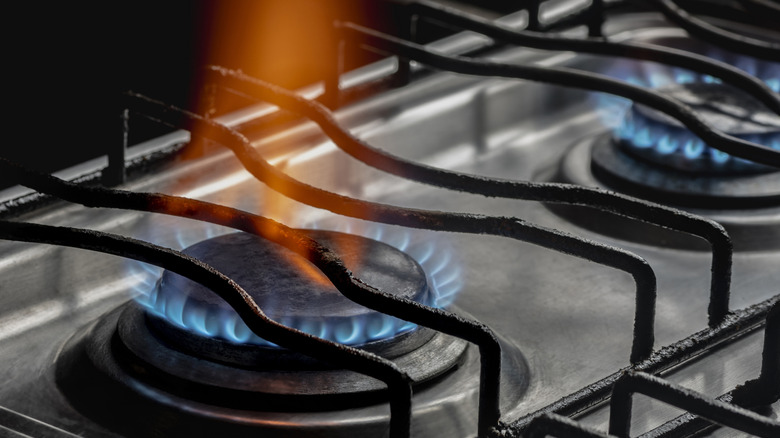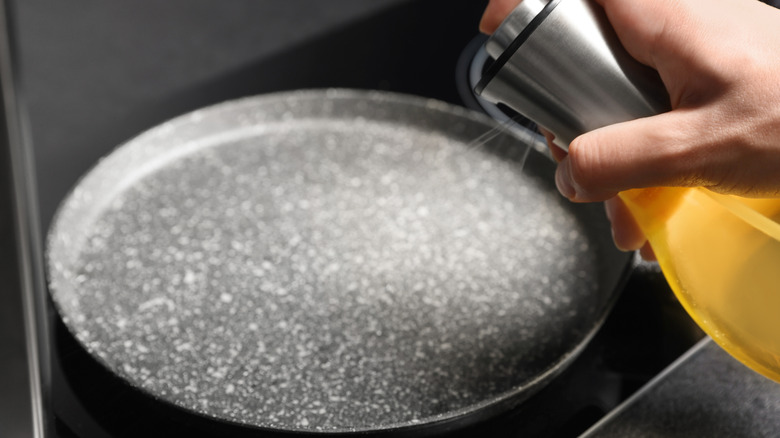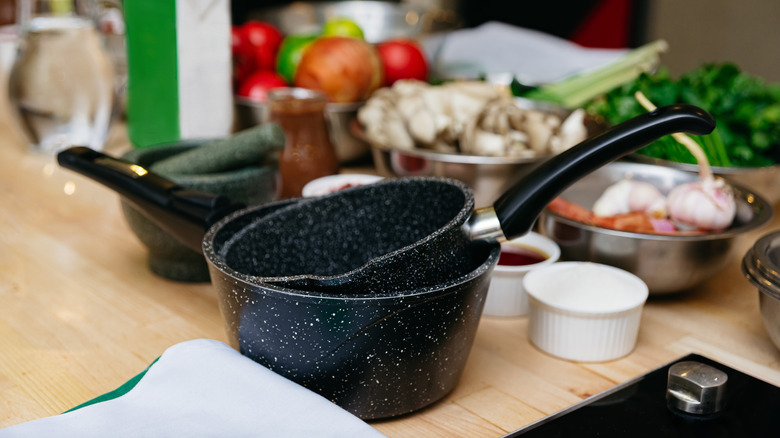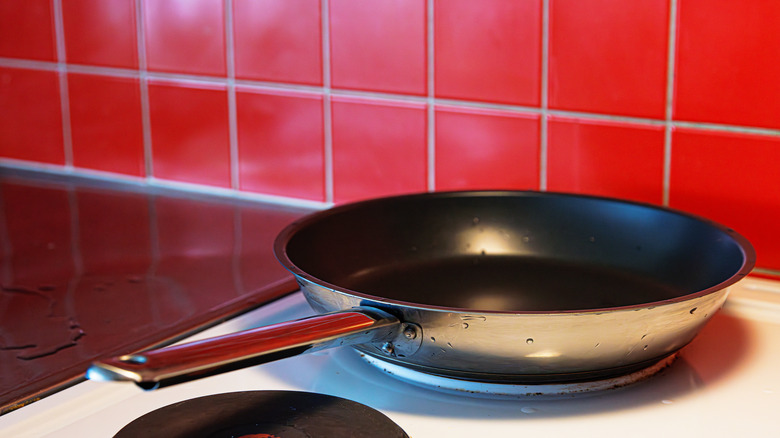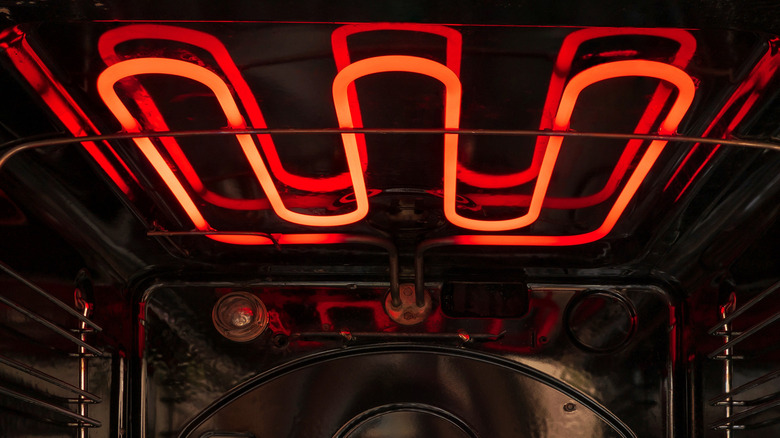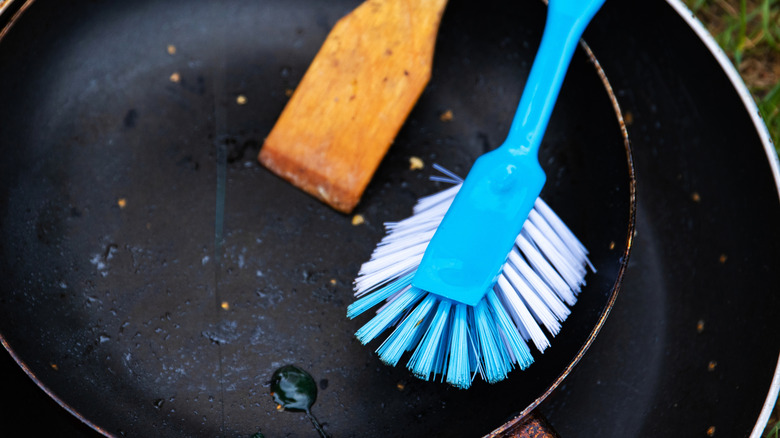Mistakes Everyone Makes With Nonstick Pans
You'll find at least one nonstick pan in most home kitchens. They're the go-to choice for some keen cooks, due to how easy they are to clean and the fact that most foods slide right off — no wrestling with a spatula required. However, there are some common mistakes everyone makes with nonstick pans.
On the (nonstick) surface, they're a straightforward addition to any culinary arsenal. You don't need to use much oil, cleaning them doesn't involve scrubbing, and it doesn't seem like there are any tricks to using them correctly, unlike stainless steel or cast iron pans. But, when you look more closely, there are more dos and don'ts than you might realize. And that's why many people are caught by some of their common pitfalls.
Whether you're washing them incorrectly, using the kind of oil that you shouldn't, or using them when they need to be tossed in the trash, there's more that you can do wrong with them than you might realize. It's no cause to panic, though. Yes, there may be some things you need to learn. But, once you've got your head around them, it's plain sailing. Avoid these common missteps with nonstick pans and they'll last longer and perform better.
Putting nonstick pans in the dishwasher
If, once you're done cooking, you put your nonstick pans in the dishwasher, you're making a mistake. We're sorry to say this, but nonstick pans should always be washed by hand. We know how much easier it is to load all your dirty dishes into an appliance and hit a button than to clean them manually, but trust us on this.
The reason you should never put nonstick pans in the dishwasher is that it will wear away the coating more quickly. The reason that food doesn't stick to these pans is that they're made from metals that have been coated in substances like Teflon. It's the coating that prevents sticking, so once it chips off or wears away, the pan is no good. And that's before we even mention the potential concern of consuming flakes of the coating in your food.
The higher water temperatures and harsher detergents that cookware is exposed to in the dishwasher isn't good for that coating. It thins it out and wears it away more quickly. So, yes, it will take you extra time and some elbow grease, but it's worth washing your nonstick pans by hand. Even tougher options that claim to be dishwasher safe will last longer this way.
Using nonstick pans for everything
Nonstick pans absolutely have their place in the kitchen, but don't feel like you have to use them for everything. Not every dish needs the benefits this type of cookware brings. And, in fact, there are some dishes that are actively better when cooked in pans made from materials like stainless steel or cast iron. If you learn when to use nonstick pans and when to leave them in your kitchen cabinet, they'll last longer and your food will turn out better.
Eggs are one of those things that are almost always best cooked in a stainless steel skillet. Fried or scrambled, they have a propensity to stick to the bottom of pans. They end up getting burned and stuck fast, and can ruin your meal and your cookware. Crêpes are also so much easier to get right in nonstick pans. They're so fine and delicate that flipping them without tearing can be tricky in pans made from other materials. Anything cheesy that oozes is also the perfect candidate for cooking in nonstick, as the melted cheese can stick firm.
But, when you're boiling up rice or pasta or simmering a sauce, there's no need for nonstick properties. If you're managing to get noodles stuck to the bottom of your pan, you're doing something wrong. And sometimes, nonstick coatings actively impinge on a dish, such as when you want to sear an ingredient.
Keeping scratched or dented nonstick pans
If your nonstick pans are scratched or dented, it's time to think about replacing them. While it might feel wasteful to toss out cookware that still technically "works," damage to the surface or structure of a pan changes how it performs. Any scratches or dents are the warning signs you need to replace your nonstick pans.
One of the issues is that scratches compromise the nonstick coating itself. That slick surface is what keeps food from clinging and makes cleanup so easy. Once it's damaged, things start to stick, and you'll find yourself needing more oil or butter to get the same results. Worse, flakes of the coating can break off and wind up in your food. While modern nonstick materials are considered safe when intact, they're not meant to be ingested. Plus, there are some caveats. Any pan made before 2015 may contain more harmful chemicals. And even though technically safe, newer coatings still release microplastics into your food when scratched.
Dents pose their own set of problems. A warped pan won't sit flat on the stovetop, which means uneven heating. Instead of a pancake that browns evenly, you might get one side scorched while the other is barely cooked. Liquids can pool in the low spots, sauces reduce unevenly, and delicate dishes are far harder to control. Overall, a dented nonstick pan simply won't cook the way it's supposed to. So, retire scratched or dented pans, and you'll notice your cooking instantly improves.
Stacking nonstick pans
Many of us stack our pans on shelves or in kitchen cabinets to save space. But, if you do this with nonstick pans, you're asking for trouble. The smooth coating that makes them so useful is easy to damage. When pans rub together, the surface can get scratched or worn. Eventually, this can flake off tiny pieces of the coating, which may end up in your food.
Even if you think that it's not too big a deal, assuming they might get a little more wear but it's not the end of the world, there's another issue. In many cases, stacking your nonstick pans or storing them with lids in between them, will void any warranty they come with. So, if you're forked out on expensive nonstick cookware because of the peace of mind a warranty brings, you won't be able to claim it when you store your pans this way.
One option is to use separators and store the lids separately. These separators offer protection to keep one pan from scratching another. You could also choose to hang then if you have space for that. Spend a few extra seconds arranging your pans and you'll save frustration, money, and performance.
Using metal utensils
You might have your favorite metal spatula that's perfectly thin for getting underneath food and feels good to hold. But, it would be a mistake to use this in your nonstick pan. In fact, using metal utensils of any kind is an error.
But, what's the deal? Well, quite simply, the hard, somewhat sharp edges of metal utensils scratch the surface of nonstick pans. This is one of the reasons why your nonstick pans stick. These scratches degrade the quality of the coating until it no longer works as it should. Eventually, it can chip or flake the coating, too, and it can end up in your food, which nobody wants.
Using metal utensils might not make noticeable scratches to the coating right away, but this doesn't mean that it's okay. You might use a metal spatula once, not notice a difference, and think you're getting away with it. But, actually, unless you gouge away at the surface with a knife, you might not see scratches right away. Rather, they build up over time. So do yourself and your cookware a favor — use wooden, nylon, or silicone utensils instead. The nonstick coating will last longer and you won't end up eating it.
Washing nonstick pans while they're still hot
It's tempting to wash your nonstick pan the second you've finished cooking, especially when you want to get some of the dishes out of the way before you eat so you can relax after dinner. But washing it while it's still hot is a bad idea.
The big issue is thermal shock. Nonstick pans are often made from thin aluminum and don't love sudden temperature changes. Dunking a blazing-hot pan into cold water can warp the base so it no longer sits flat. That warped pan will heat unevenly next time, giving you hotspots and uneven browning.
It can also stress the coating. The nonstick layer expands and contracts with temperature. Rapid cooling stresses the coating and the bond between it and the metal. Over time this speeds up flaking and loss of nonstick performance.
So, even when you're in a hurry, you should let the pan sit to cool before you wash it. Once cool, it won't experience the thermal shock of cooler water hitting the hot material, so you can wash it without damaging it. We get that sometimes you want to get the dishes done right away, but your cookware will last longer and work better if you wait.
Using nonstick pans for sauces and gravy
The nonstick pan mistake that's making your food less flavorful is using this kind of cookware to make sauces and gravies. Nonstick pans are great for some things but are poor partners for pan sauces for one simple reason: the coating prevents browned bits from sticking and accumulating. That means less depth of flavor when you try to deglaze, and a thinner, less complex sauce as a result.
This is all down to something known as fond, which is the tasty, browned residue left on a pan after you sear meat or vegetables. Those little caramelized bits and concentrated juices that cling to the surface. It's literally the French word for base, because once you deglaze those browned bits with wine, stock, or vinegar, they become the backbone of a pan sauce or gravy.
To build good fond you need high, dry heat to encourage Maillard browning. But most nonstick cookware shouldn't be pushed to those temperatures, so you get less browning to begin with. Plus, something about the coating means it just doesn't stick and build up no matter what you do. If you love pan sauces, reach for stainless steel or cast iron. You'll build up that fond for a tastier sauce.
Cooking at high temperatures
It's normal to occasionally crank the burner up to full temperature to get a good sear or speed things along. But, cooking at high temperatures in a nonstick pan is a mistake. Nonstick coatings are engineered to work at low-to-moderate heat. Push them too hot and the coating starts to degrade, shortening the pan's life. Over time, that microscopic breakdown makes sticking worse and increases the chance of flakes ending up in your food.
There's also a safety angle. When nonstick coatings overheat they can release fumes. It's the scary way a nonstick pan can turn toxic. The phenomenon is known as Teflon flu or polymer fume fever. For most people these are fairly mild — coughing, fever, and tightness in the chest — but some people can be more sensitive. Pets, especially birds, are particularly vulnerable to airborne toxins from overheated cookware, so keep them away from the kitchen when you're using potentially risky pans.
Once nonstick coatings are exposed to heats of over 500 degrees Fahrenheit, that's when these fumes start to be released. They're also more likely to cause problems if the surface of the pan is scratched — more reason to toss damaged nonstick pans. While symptoms usually get better within 48 hours and there are no known long-term effects, you can't totally rule them out, so don't take this risk lightly.
Using cooking spray on a nonstick skillet
You don't have to use much oil or butter in a nonstick skillet — though if you want to do so for flavor, go right ahead. So, it might seem like a sensible idea just to use a bit of cooking spray. However, using aerosol sprays on nonstick pans isn't a good idea.
You might wonder why it's fine to use oil in a pan but not a cooking spray. But, the reason is simple. Cooking sprays aren't just oil. They also contain emulsifiers, propellants, and anti-foaming agents. These extra ingredients can form a sticky layer on top of the existing nonstick coating that's difficult to wash off. Over time, this can actually make food stick to your pan, defeating the object of a nonstick skillet in the first place. So, put down the cooking spray and don't be afraid of using actual oil or butter.
Buying nonstick saucepans
Some people will go out and buy a whole matching set of nonstick pots and pans. For many, this seems like the most straightforward option. Buy everything in one go and stock your kitchen with minimal fuss. But buying nonstick saucepans and stockpots doesn't make sense. The reason nonstick coatings exist is to prevent sticking, but generally, that isn't an issue in a saucepan.
The only type of nonstick pan you should be using is a skillet or a frying pan. Some particularly suggest a 10-inch pan, as this is a versatile choice, but pick whatever size makes sense for you and what you like to cook. And leave those nonstick saucepans on the shelf. Instead, choose saucepans made from materials like stainless steel or enameled cast iron.
But, why does it matter? Can't you just use nonstick for everything even if you don't really need it? Well, sure, you can, but it's not the best idea in the long run. Firstly, nonstick pans aren't durable. Even quality ones are likely to need replacing within a few years. Good quality cast iron or stainless steel options, on the other hand, can last a lifetime. On top of that, we're not yet 100% sure of the long-term health effects of nonstick coatings, even if they're currently considered safe. So, using them as little as possible is advisable.
Heating an empty pan
If you've been heating up your nonstick pans empty before adding oil or other ingredients, stop. We've already explained that you shouldn't use this kind of cookware at too high a heat because it damages the coating and releases fumes. Well, pans get very hot quickly when they're empty. So, you're likely to go over the recommended maximum temperature of 500 degrees Fahrenheit when you leave a nonstick pan empty on a hot stovetop.
It can be confusing because it's the opposite of how you treat stainless steel or cast iron. Those skillets are often heated empty on purpose. A dry preheat creates an even, hot surface that helps form a sear and reduces sticking once you add oil. Cast iron and stainless tolerate and benefit from high heat, while nonstick does not.
With nonstick, add a little oil or butter and heat gently on low–medium before putting food in. That small change protects the coating, keeps fumes at bay, and helps the pan behave the way you expect.
Using a nonstick pan under the broiler
There may be times when you're tempted to put your cast iron pan under the broiler. For instance, to finish off a frittata or to melt cheese on top of a patty. However, this is a big mistake since the two should never meet.
If you're wondering why you should never use non-stick pans under the broiler, there's a simple reason: broilers are very hot. Because of the high, direct heat, a pan under the broiler can quickly reach over 500 degrees Fahrenheit, which is the maximum safe heat for most nonstick pans. This can cause fumes to be released and make the coating break down quicker, neither of which you want.
Using nonstick pans in the oven is fine, assuming the temperature is set below 500 degrees Fahrenheit. That said, you should check the specifics for your particular pan. Some have lower safe temperatures, while others have handles of plastic or wood that shouldn't go in the oven.
Cleaning nonstick pans with scourers or harsh detergents
If you want to make your nonstick pans last as long as possible, how you clean them is important. Avoid using harsh detergents or scourers that could affect the lifespan of your pans and keep things more gentle. You'll find you usually don't need anything heavy duty to clean this kind of pan, anyway.
We've already covered the fact that you should hand wash nonstick pans, but the care instructions don't end there. Use a soft sponge or a cloth rather than a scourer to avoid scratching the coating. Steel wool is the most abrasive, but even the scrubby side of a dish sponge can do damage over time. Because these pans are nonstick, you generally don't need to scrub them. However, if you have somehow managed to get something stuck in there, soak it to soften it up instead of using brute force.
You should also use a mild dish soap. Harsh detergents can also break down the nonstick coating more quickly. An average dish washing liquid will be just fine, but if you're concerned, use a sensitive or natural formula.
